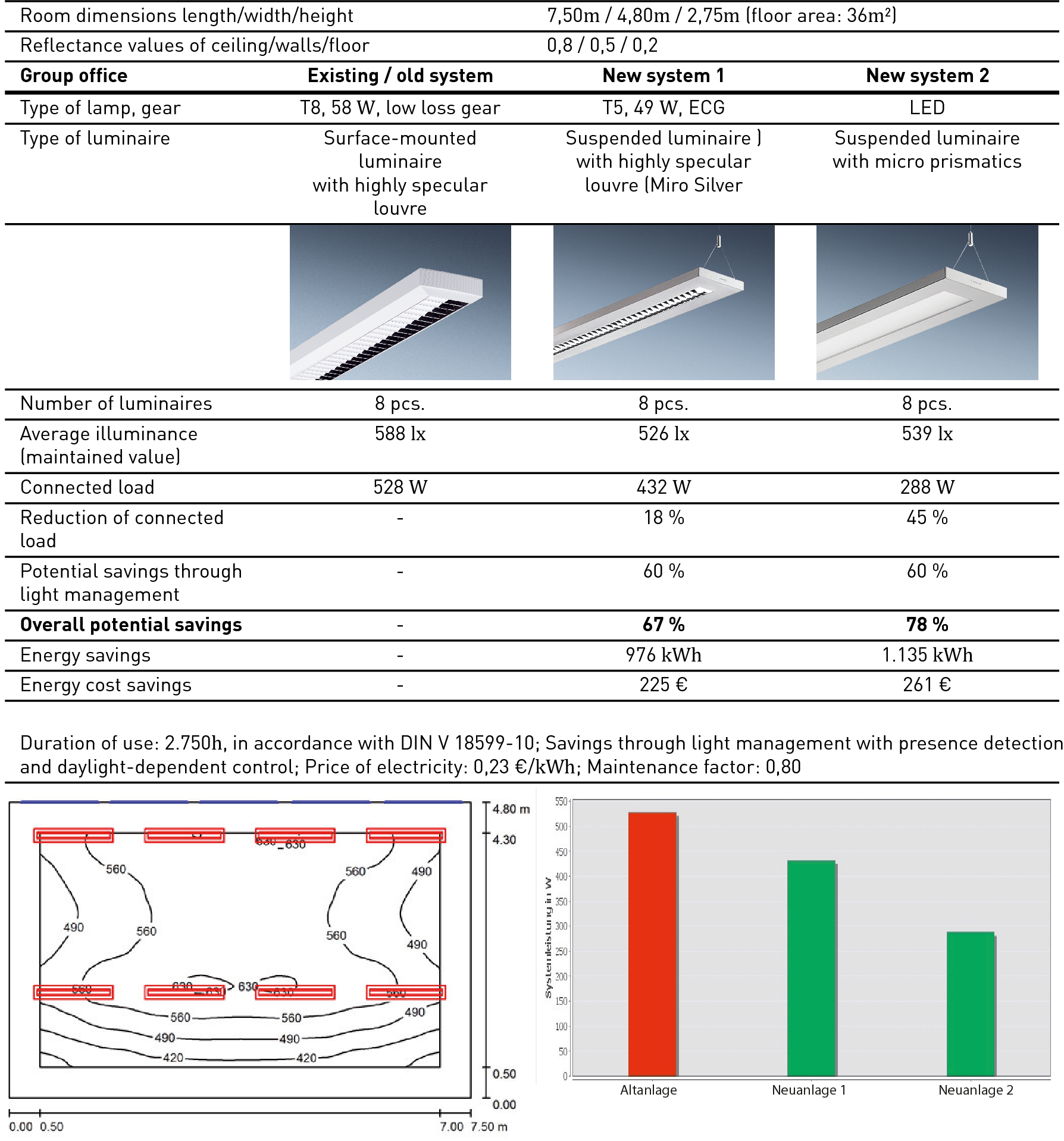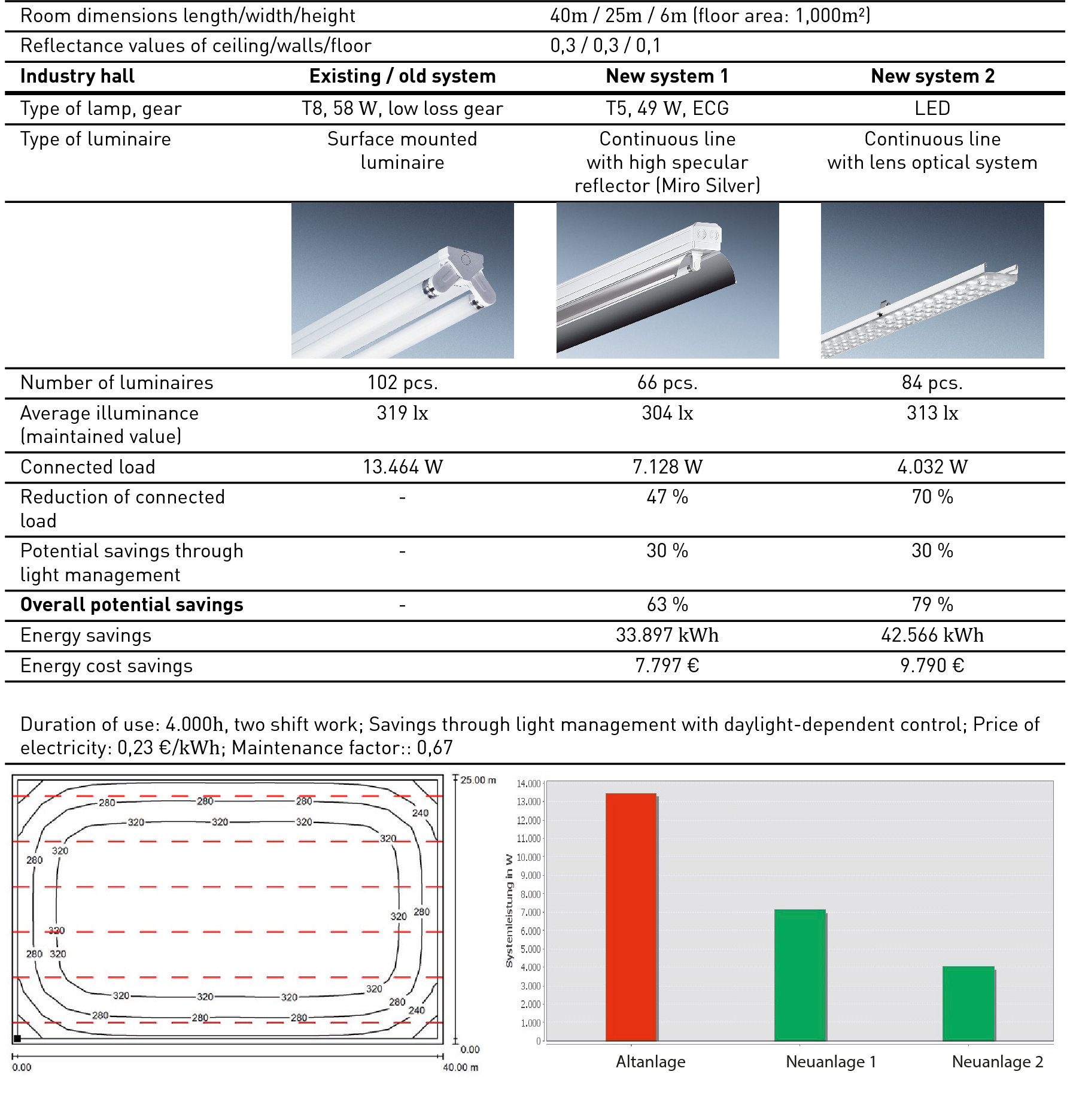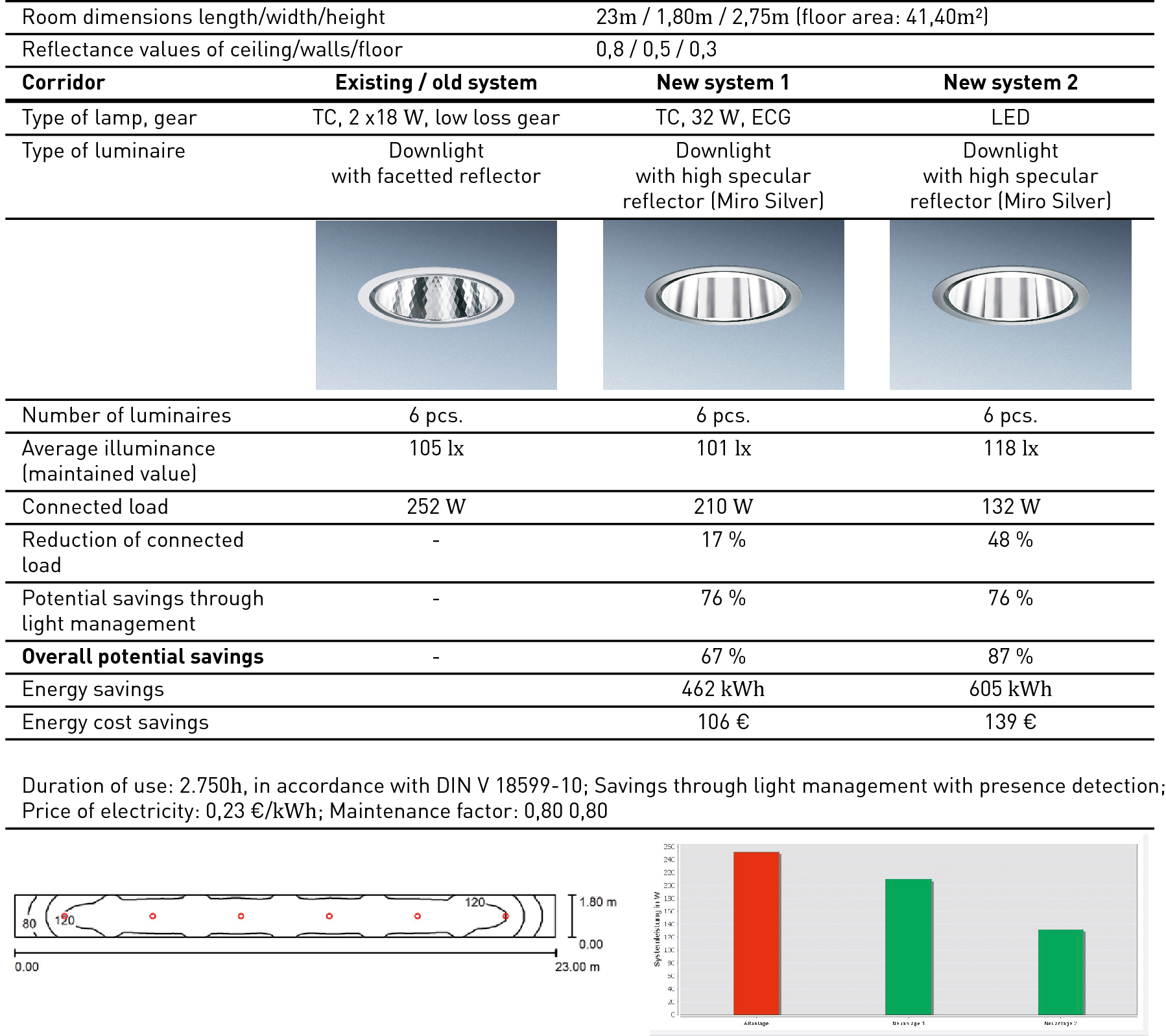The following examples show planning results for lighting installation refurbishments with the aim of achieving a reduced energy demand and energy costs with similar or improved photometric characteristics of the lighting installation.
Refurbishment examples
Where design-oriented luminaires or luminaire arrangements are preferred, a slightly higher energy consumption would probably be tolerated in favour of architectural effects when compared to installations where energy minimisation is the primary planning objective.
The data in the following tables represents sample results for photometric planning according to EN 12464-1. It is based on an assumed energy rate of 0,23 €/kWh. The specified operating times correspond to the times of use assigned to the user profiles for certain applications by the standard DIN V 18599-10 (see also chapter "Light and the environment").
Regarding the illuminance levels achieved with the old installation, the considerations are based on initial illuminance. This means that theoretical comparisons of old and new installations give results that are not entirely realistic. Realistic comparisons need to be based on photometric measurements of the old installations. These will also make the results clearer.
The following examples are based on room-related general lighting. Consequently, the illuminance values refer to a working area which corresponds to the room’s surface area minus a narrow marginal band along the walls.
In each example, the old installation is assumed to be composed of T8 fluorescent lamps with low-loss control gear as commonly used ca. 20 years ago, which is then contrasted with two refurbishment variants:
one with T5 fluorescent lamps,
the second with LED luminaires.
The maintenance factor which serves as a basis for calculations is specified with the same value for the old installation and both new installations and can be found in the table caption.
The figures with the room floor plan, the working area and the luminaire arrangement are gathered from the corresponding design. The isolux curves (curves of identical maintained illuminance) apply to new installation 2.
Example 1 – office:
The planning objective is the renewal of the lighting in a very clean non-smoking office with two angled desk combinations. So far, 8 surface-mounted single-lamp luminaires with highly specular VDU louvres had been installed. The reasons for refurbishment are energy savings and improvements in visual conditions as well as lighting atmosphere, in particular regarding the luminance distribution and the avoidance of distracting reflections on horizontal work surfaces. Refurbishment can be executed with suspended single-lamp, direct-indirect-distribution ceiling luminaires with highly specular louvres and tubular tri-phosphor
fluorescent lamps 1 x 49W/T5, with ECG
or with suspended direct-indirect-distribution ceiling luminaires with LED and microprismatic covers.
Both new installations with suspended luminaires exhibit a significant improvement in lighting quality compared to the old installation. The connected load as well as the energy costs of the installation equipped with LED luminaires are the lowest compared to the other installations. Both new installations facilitate significant savings via light management with presence detection and daylight-dependent control. The latter is defined as the reference technology in the energy savings regulation (EnEV 2014) (see also chapter ). The energy costs for new installation 2 are reduced by 78% compared to the old installation.

Table 3.32: Example 1: Refurbishment in a group office
Example 2 – Manufacturing hall
The manufacturing hall with a floor area of 1.000 m2 used to be illuminated by 102 batten luminaires, 2 x 58 W, LLCG. The installation had to be modernised since the glare limitation of the batten luminaires did not comply with standards and provisions for occupational health and safety and led to complaints. Ceiling soiling had a significant effect on the decrease in illuminance, since the batten luminaires projected too much light onto the hall ceiling and the batten lamps themselves were subject to increased soiling. Energy consumption was to be reduced.
The choice was to be made between white continuous line reflector luminaires with tri-phosphor lamps, 2 x 49 W/T5, and alternatively continuous line LED luminaires with narrow-distribution lens optics and 6.600 lm. Illuminance in both cases fulfils minimum requirements according to EN 12464-1 for working e.g. at automatic cutting presses (300 lx). Glare limitation in the new installations is standard-compliant (see table "Metalworking and metal processing").
Connected load can be reduced by 47% or 70%, respectively. With two-shift operation at an operating time of 4.000 hours per year and using daylight-dependent constant light control, more than 9.500 € in energy costs are saved per year.

Table 3.33: Example 2: Refurbishment in a production hall
Example 3 – Corridor
Corridors in administrative buildings and many industrial or handcraft companies are often illuminated all day in spite of long periods of time without persons present, whether it is necessary or not. This holds particular refurbishment potential. In this example, a 23 m section of a long corridor is examined. It was suggested to replace the old downlights featuring 2 compact fluorescent lamps TC 18W and LLCG each either with downlights featuring 1 compact fluorescent lamp with highly specular reflector and ECG or with modern LED downlights.
Illuminance for all cases fulfils the requirements of EN 12464-1. Energy costs, however, differ significantly: The new installation with 2 LED luminaires saves 87% in energy. This is partly due to the insensitivity of LED luminaires to short switching cycles. In the example, it is assumed that the occurring relative absence of persons of 80% according to DIN V 18599-10 (see also chapter "Light and the environment") can be used almost completely for energy-saving. With compact fluorescent lamps, there are fewer turn-off times, since a minimum operating period of 10 minutes between turning on and off should not be undercut for these light sources. Otherwise, it must be anticipated that the expected useful service life of the light source is significantly reduced.
At 2.750 hours of operation per year, this relatively short corridor section of 23 m length can already save up to 130 € per year in energy costs. In administrative buildings, the total length of corridors generally adds up to several times that value, and consequently many times this amount of energy cost savings can be anticipated.

Table 3.34: Example 3: Refurbishment in a corridor